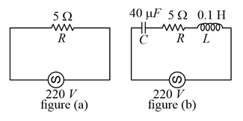MEDIUM
Earn 100
The phase difference between current and ac source voltage is . If rms value of current and voltage is and respectively, then power dissipated in the circuit is
Important Questions on Alternating Current
EASY
MEDIUM
EASY
?
EASY
HARD
EASY
MEDIUM
EASY
MEDIUM
EASY
EASY
EASY
MEDIUM
EASY
HARD
Two circuits are shown in figure and . At a frequency of _______ the average power dissipated in one cycle will be the same in both the circuits.

EASY
A small town with a demand of of electric power of is situated away from an electric plant generating power at . The resistance of the two wireline carrying power is The town gets power from the line through a step-down transformer at a sub-station in the town. Estimate the line power loss in the form of heat.
EASY
MEDIUM
EASY
MEDIUM

